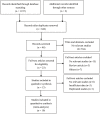Correlation Between Soluble Klotho and Vascular Calcification in Chronic Kidney Disease: A Meta-Analysis and Systematic Review
- PMID: 34483963
- PMCID: PMC8414804
- DOI: 10.3389/fphys.2021.711904
Correlation Between Soluble Klotho and Vascular Calcification in Chronic Kidney Disease: A Meta-Analysis and Systematic Review
Abstract
Background: The correlation between soluble Klotho (sKlotho) level and vascular calcification (VC) in patients with chronic kidney disease (CKD) remains controversial. Using meta-analysis, we aimed to address this controversy and assess the feasibility of applying sKlotho as a biomarker for VC. Methods: Medical electronic databases were thoroughly searched for eligible publications on the association between sKlotho level and VC in CKD patients. Effectors, including correlation coefficients (r), odds ratios (ORs), hazard ratio (HR) or β-values, and 95% confidence intervals (CIs) were extracted and combined according to study design or effector calculation method. Pooled effectors were generated using both random-effects models and fixed-effects models according to I 2-value. Origin of heterogeneity was explored by sensitivity analysis and subgroup analysis. Results: Ten studies with 1,204 participants from a total of 1,199 publications were eligible and included in this meta-analysis. The combined correlation coefficient (r) was [-0.33 (-0.62, -0.04)] with significant heterogeneity (I 2 = 89%, p < 0.001) based on Spearman correlation analysis, and this significant association was also demonstrated in subgroups. There was no evidence of publication bias. The combined OR was [3.27 (1.70, 6.30)] with no evidence of heterogeneity (I 2 = 0%, p = 0.48) when sKlotho was treated as a categorical variable or [1.05 (1.01, 1.09)] with moderate heterogeneity (I 2 = 63%, p = 0.10) when sKlotho was treated as a continuous variable based on multivariate logistic regression. No significant association was observed and the pooled OR was [0.29 (0.01, 11.15)] with high heterogeneity (I 2 = 96%, p < 0.001) according to multivariate linear regression analysis. There was an inverse association between sKlotho and parathyroid hormone levels. The combined coefficient (r) was [-0.20 (-0.40, -0.01)] with significant heterogeneity (I 2 = 86%, p < 0.001), and without obvious publication bias. No significant association was found between sKlotho and calcium or phosphate levels. Conclusion: There exists a significant association between decreased sKlotho level and increased risk of VC in CKD patients. This raises the possibility of applying sKlotho as a biomarker for VC in CKD populations. Large, prospective, well-designed studies or interventional clinical trials are required to validate our findings.
Keywords: biomarker; chronic kidney diease; management; sKlotho; vascular calcifcation.
Copyright © 2021 Liu, Yu, Yin, Ye and Li.
Conflict of interest statement
The authors declare that the research was conducted in the absence of any commercial or financial relationships that could be construed as a potential conflict of interest.
Figures







Similar articles
-
Serum and Urinary Soluble α-Klotho as Markers of Kidney and Vascular Impairment.Nutrients. 2023 Mar 18;15(6):1470. doi: 10.3390/nu15061470. Nutrients. 2023. PMID: 36986200 Free PMC article.
-
Correlation between soluble klotho and chronic kidney disease-mineral and bone disorder in chronic kidney disease: a meta-analysis.Sci Rep. 2024 Feb 23;14(1):4477. doi: 10.1038/s41598-024-54812-4. Sci Rep. 2024. PMID: 38396063 Free PMC article.
-
The Prognostic Role of Klotho in Patients with Chronic Kidney Disease: A Systematic Review and Meta-analysis.Dis Markers. 2019 Jun 2;2019:6468729. doi: 10.1155/2019/6468729. eCollection 2019. Dis Markers. 2019. PMID: 31275449 Free PMC article.
-
The prognostic value of soluble Klotho in patients with haemodialysis: a systematic review and meta-analysis.Ther Adv Chronic Dis. 2020 Jul 30;11:2040622320940176. doi: 10.1177/2040622320940176. eCollection 2020. Ther Adv Chronic Dis. 2020. PMID: 35154625 Free PMC article.
-
Correlation between Soluble α-Klotho and Renal Function in Patients with Chronic Kidney Disease: A Review and Meta-Analysis.Biomed Res Int. 2018 Aug 12;2018:9481475. doi: 10.1155/2018/9481475. eCollection 2018. Biomed Res Int. 2018. PMID: 30159331 Free PMC article. Review.
Cited by
-
Vascular Calcification: Molecular Networking, Pathological Implications and Translational Opportunities.Biomolecules. 2024 Feb 25;14(3):275. doi: 10.3390/biom14030275. Biomolecules. 2024. PMID: 38540696 Free PMC article. Review.
-
Soluble Klotho, a Potential Biomarker of Chronic Kidney Disease-Mineral Bone Disorders Involved in Healthy Ageing: Lights and Shadows.Int J Mol Sci. 2024 Feb 3;25(3):1843. doi: 10.3390/ijms25031843. Int J Mol Sci. 2024. PMID: 38339121 Free PMC article. Review.
-
Potential application of Klotho as a prognostic biomarker for patients with diabetic kidney disease: a meta-analysis of clinical studies.Ther Adv Chronic Dis. 2023 Dec 4;14:20406223231213246. doi: 10.1177/20406223231213246. eCollection 2023. Ther Adv Chronic Dis. 2023. PMID: 38058396 Free PMC article.
-
Serum and Urinary Soluble α-Klotho as Markers of Kidney and Vascular Impairment.Nutrients. 2023 Mar 18;15(6):1470. doi: 10.3390/nu15061470. Nutrients. 2023. PMID: 36986200 Free PMC article.
-
Nonlinear relationship between serum Klotho and chronic kidney disease in US adults with metabolic syndrome.Front Endocrinol (Lausanne). 2024 Dec 24;15:1409560. doi: 10.3389/fendo.2024.1409560. eCollection 2024. Front Endocrinol (Lausanne). 2024. PMID: 39777219 Free PMC article.
References
Publication types
LinkOut - more resources
Full Text Sources

